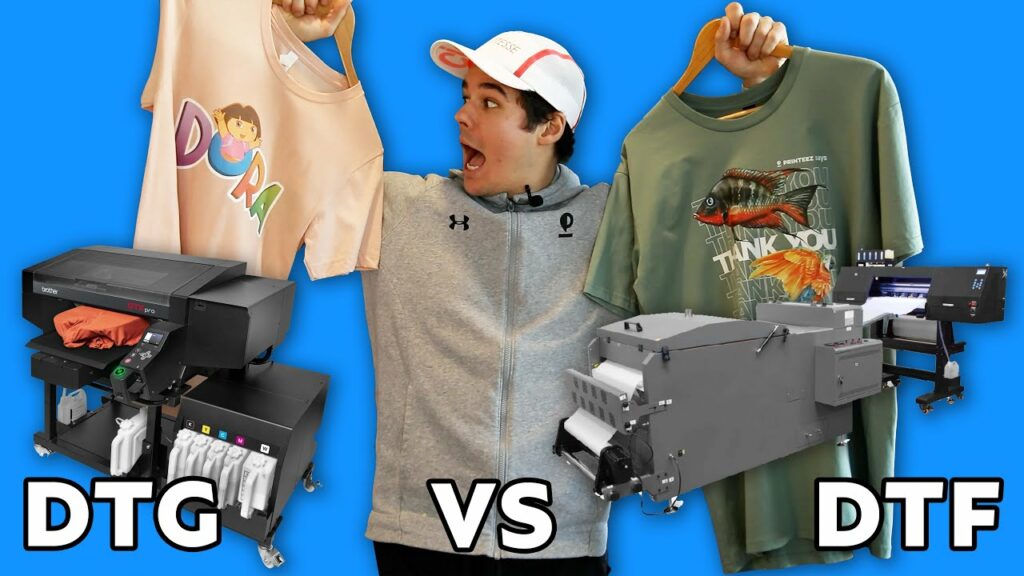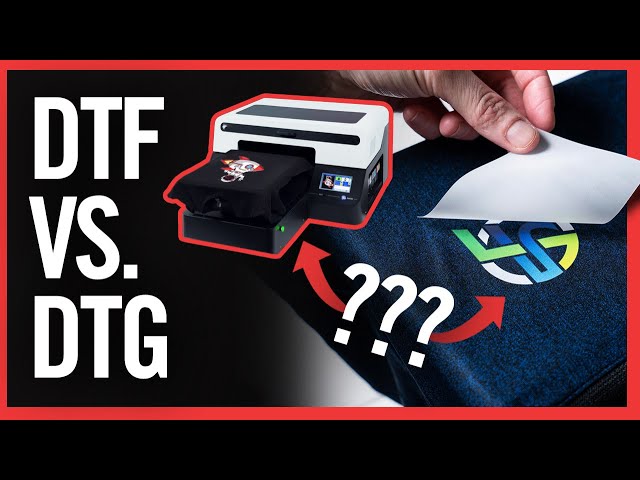
Introduction
In the dynamic realm of garment printing, two techniques have been creating a buzz. DTF printing and DTG printing. As businesses explore innovative ways to bring designs to life on fabric, the question arises. – is DTF printing better than DTG printing? Let’s embark on a colorful journey through these two printing processes. And unravel the threads that make each unique.
DTF vs. DTG Printing – Understanding the Fundamentals
Digital printing techniques like DTF and DTG printing are a step forward from conventional screen printing. DTG uses a slightly different method, while DTF prints directly into the fabric. In DTF, the design is applied to the clothing using a film. While each approach has its advantages, the devil is in the details.
DTF Printing: The Up-and-Coming Entity

Direct to Film, or DTF, is the printing industry’s newest bright spot. Using a solvent-based ink, graphics are printed onto a specific film during the process. Once the pattern is on the film, it’s transferred to the fabric using a heat press. The adaptability of this technique allows printing on a variety of materials, such as mixes, cotton, and polyester.
Advantages of DTF Printing
Bright Colors:
DTF printing is excellent at creating vibrant, striking colors. The highly penetrating solvent-based inks give textiles vibrant, lifelike designs.
Versatility in Fabrics:
DTF is not selective in its choice of textiles. DTF adapts effortlessly to any material—cotton, polyester, or a blend—providing a wider canvas for your creative pursuits.
Cost-Effectiveness:
For large orders, DTF printing frequently works out to be more economical. The process’s efficiency and the variety of cloth options provide a pricing advantage over competitors.
Durability:
DTF printing ink has a tendency to be more resilient with designs resisting wear and repeated washings. Your masterpieces will last the test of time thanks to their durability.
DTG Printing: The Old Hand in the Game

Direct to Garment (DTG) printing has been a stalwart in the garment printing industry. It offers a reliable and precise method for bringing designs to life on fabrics. Often referred to as the “old hand in the game,” DTG printing has earned its place through a combination of advanced technology. And a commitment to delivering high-quality prints.
Advantages of DTG Printing
Fine Details and Intricate Designs:
DTG printers use technology that makes it possible to reproduce intricate artwork. Similar to high-end inkjet printers. This makes printing minute details that would otherwise be difficult to print with conventional methods. Because of this, DTG is a great option for designs that use gradients, small lettering, or intricate patterns.
Comfortable Handfeel on Material:
DTG printing is well known for giving fabrics a velvety feel. This feature is especially useful for designs that cover a lot of surface area or are meant to be worn near to the skin. The DTG method produces a breathable, pleasant finish. Since the water-based inks penetrate the fabric in this way. This light touch improves the printed garment’s general wearability. Hence, making it a better option for clothing that requires a delicate touch.
Perfect for On-Demand Printing and Small Orders:
DTG works effectively for bigger production runs. But on-demand printing and small orders are where it really shines. In lesser volumes, traditional printing techniques like screen printing are less cost-effective due to their high setup requirements. DTG printing doesn’t require a lot of setup. This leads organizations to print small batches in a quick manner. This adaptability is a blessing for companies experimenting with limited-edition products. Or serving niche markets with particular needs.
Eco-Friendly Inks:
DTG printing is known for being an eco-friendly choice. Because the inks it uses are usually water-based. The use of water-based inks is in line with the growing demand for environmentally sensitive practices. Sustainability has become a focus point in several industries, including printing. Because of this, DTG is an option that takes environmental issues into account. In addition to meeting high requirements of quality.
In-Depth Color Reproduction:
DTG printers are excellent at accurately reproducing colors. Results can be obtained that are consistent and vivid by carefully controlling the color profiles. This gives a great advantage to businesses or designers with precise color specifications. This feature guarantees that the finished product will match the intended design.
Choosing between DTF and DTG Printing

Selecting between the DTF and DTG printing techniques is a crucial choice. That depends on a number of variables. The best option will rely on the particular requirements. And priorities of your printing jobs. Both approaches have advantages. Let’s examine the important factors to think about when choosing this choice.
Project Size and Quantity:
- DTF: Ideal for bulk orders. DTF printing is often more cost-effective when producing large quantities of garments. The efficiency of the process allows for quick turnaround times. Hence,\ making it suitable for extensive projects with high-volume requirements.
- DTG: Well-suited for small to medium-sized orders. DTG’s ability to handle smaller batches without significant setup costs makes it a preferred choice. If you’re dealing with limited quantities or on-demand printing,
Fabric Compatibility:
- DTF: Versatile across various fabrics. DTF printing works well on a wide range of fabrics, including cotton, polyester, and blends. If your projects involve diverse fabric types, DTF provides flexibility.
- DTG: Best for cotton-based fabrics. While DTG can print on various materials, it tends to excel on 100% cotton garments. If your designs are primarily on cotton or cotton-rich fabrics, DTG might be the optimal choice.
Color Vibrancy and Detail:
- DTF: Vibrant colors and intricate details. DTF’s solvent-based inks penetrate fabrics deeply, resulting in vivid and eye-catching colors. The process is also adept at reproducing fine details. Making it suitable for complex and detailed designs.
- DTG: Precision in color reproduction. DTG printing, with its inkjet technology, provides precise color reproduction. It is particularly effective for intricate designs and subtle color variations. It captures details with sharpness, offering a high level of color accuracy.
Cost Considerations:
- DTF: Cost-effective for bulk orders. DTF printing in handling large quantities often proves to be cost-effective. DTF may be the more economical option if your primary concern is cost-effectiveness for extensive production runs.
- DTG: Economical for small batches. DTG’s suitability for on-demand and small-quantity printing reduces the initial setup costs. Making it a cost-effective choice. Preferably for businesses with diverse product lines. Or those testing the market with limited edition designs.
Durability and Wash Fastness:
- DTF: Durable and wash-resistant. The solvent-based inks used in DTF printing tend to be more durable. This ensures that designs withstand repeated washes and maintain their vibrancy over time.
- DTG: Soft feel with good durability. While water-based inks in DTG provide a soft feel on the fabric, the prints are generally durable. They also offer good wash fastness. Proper curing during the printing process enhances the longevity of the designs.
Sustainability:
- DTF: Considered less environmentally friendly. DTF printing involves the use of solvent-based inks, which may raise environmental concerns. If sustainability is a top priority, you are then more likely to choose other eco-friendly alternatives. DTG or water-based screen printing may be more suitable.
- DTG: Environmentally friendly option. The water-based inks used in DTG printing are generally considered more eco-friendly. They align with the growing demand for sustainable practices in the printing industry.
Conclusion
In garment printing, choosing between DTF and DTG is crucial. Each method has unique strengths. DTF is efficient for large orders with vibrant colors and diverse fabrics. Its solvent-based inks ensure durability. On the other hand, DTG excels in intricate designs, soft feel, and adaptability to smaller quantities. It uses eco-friendly water-based inks, making it sustainable. The decision depends on your project’s size, fabric type, and sustainability goals.
DTF suits bulk orders, providing cost-effectiveness and deep color penetration. DTG is ideal for smaller quantities, offering precision, a soft touch, and sustainability. It captures fine details with inkjet technology.
The conclusion emphasizes harmony between your creative goals and business needs. It’s not about superiority but finding the tool that aligns best. DTF’s vibrant hues suit expansive canvases, while DTG’s precision is perfect for detailed designs on a smaller scale. As the industry evolves, a hybrid approach may unlock new possibilities.
In the dynamic world of garment printing, whether you choose DTF or DTG, your decision is a brushstroke in the evolving tapestry of textile customization. So, armed with knowledge, let your creativity shine on the fabric canvas. In contrast, enrich the world with your printed masterpieces.
